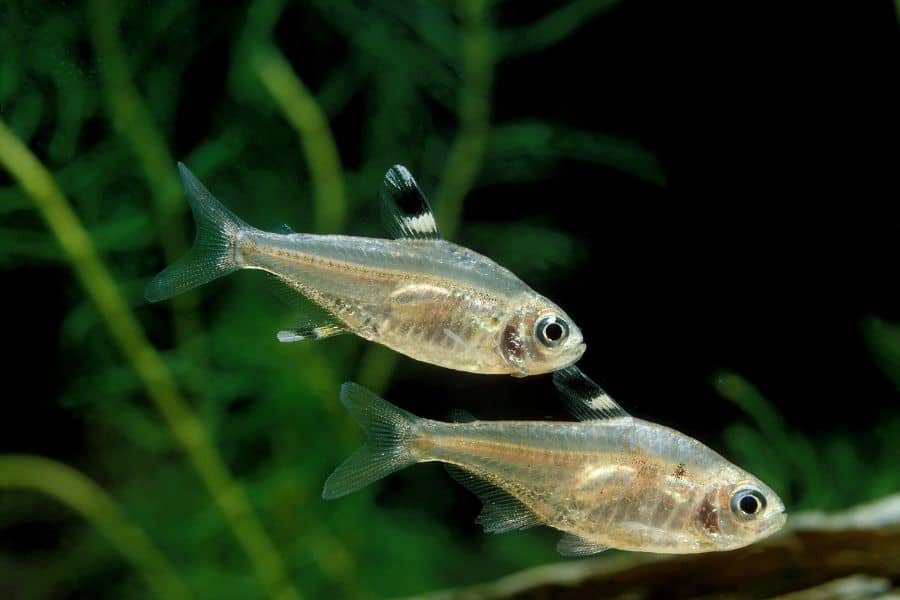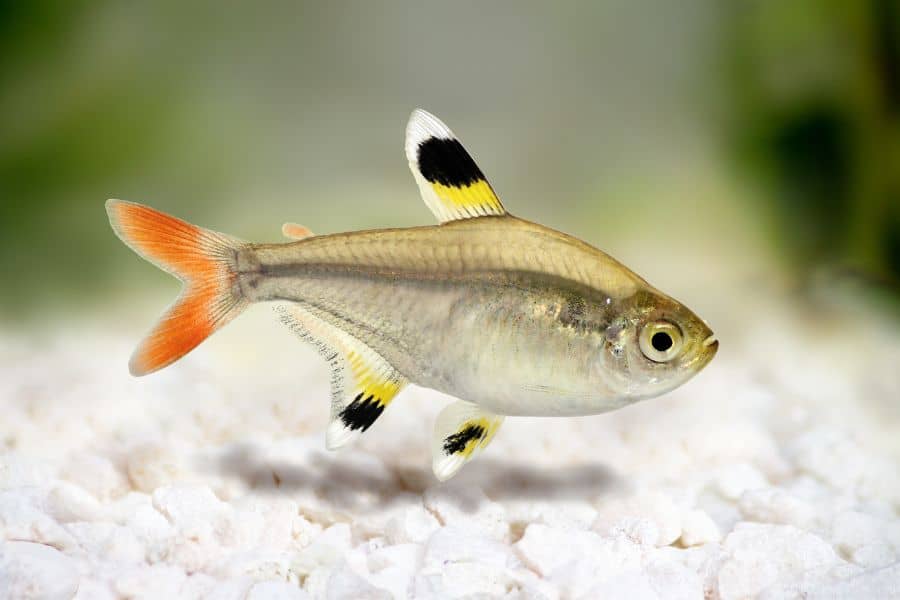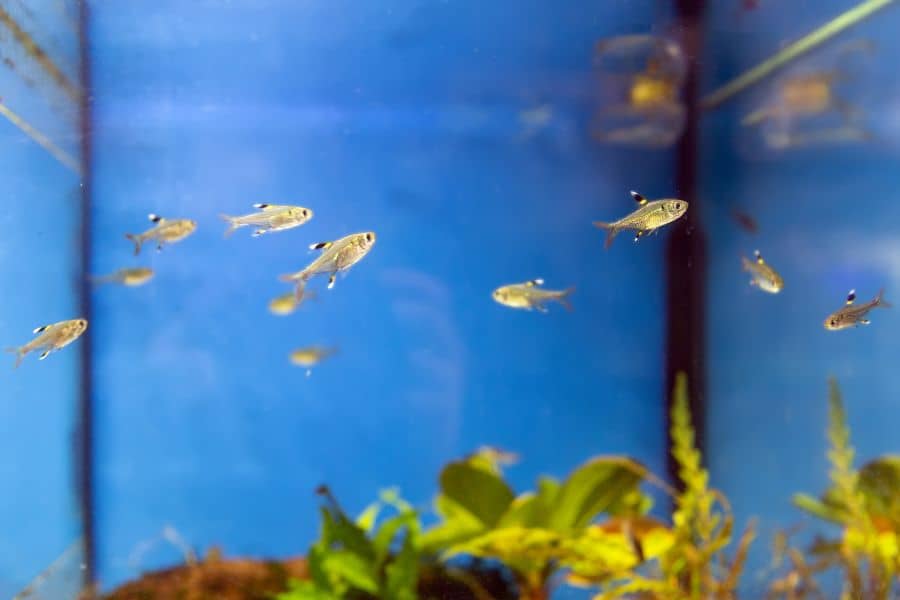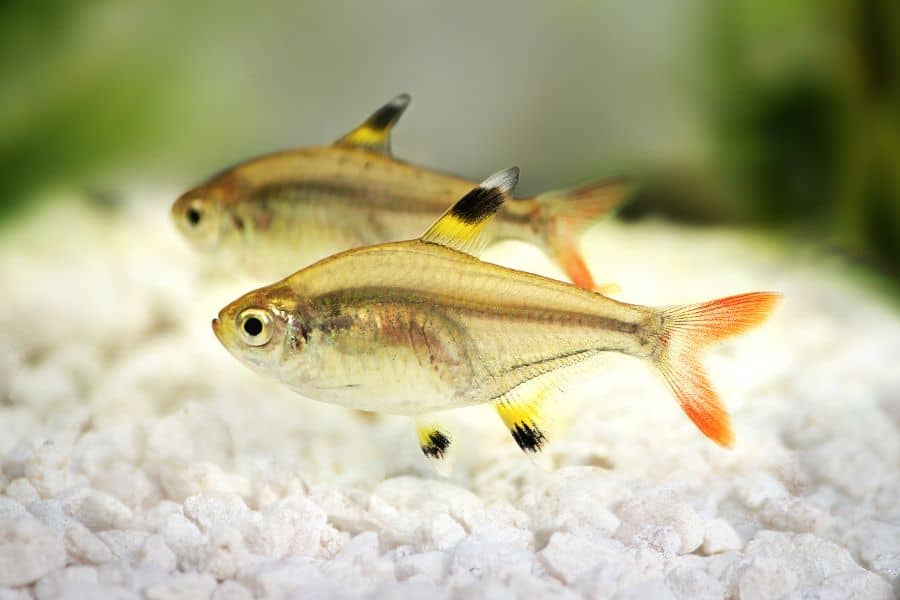X-ray tetra (Pristella maxillaris) are interesting little fish species and they will be a great addition to many types of aquariums. Their migrating behavior in the wild makes them well-suited for a community tan. Most importantly their small size means they can be kept in even the smallest of aquariums.
These lively fish are relatively easy to care and are a good choice for beginner aquarium enthusiasts. However, they are not as popular as some of the other tetra species and can be difficult to find in pet stores. If you’re thinking of adding x-ray tetras to your aquarium, read on to find out everything you need to know about their care and requirements.

What Is X-Ray Tetra?
Jump To
- 1 What Is X-Ray Tetra?
- 2 One Look Care Guide
- 3 X-Ray Tetra Size
- 4 How Long Do X-Ray Tetras Live?
- 5 Is X-Ray Tetra Aggressive?
- 6 X-Ray Tetra Behavior
- 7 X-Ray Tetra Care
- 8 X-Ray Tetra Breeding
- 9 How To Feed X-Ray Tetra?
- 10 What Fish Can Live With X-Ray Tetra?
- 11 X-Ray Tetra Diseases
- 12 Conclusion
- 13 Related Questions
X-ray tetras are native to the clear, slow-moving waters of the Guyana Shield in South America. They can be found in countries such as Brazil, Colombia, Guyana, Suriname, and Venezuela.
X-ray tetras have long been popular in aquariums because of their distinctive appearance. These small fish have translucent bodies with black and yellow vertical stripes running down their fins. Most parts of their fins are also transparent, except for the tips of the dorsal and anal fins, which are black.
Interestingly, these fish can survive in both freshwater and brackish waters due to their special ability to change the amount of salt in their bodies to match their surroundings. In the wild, x-ray tetras are known to migrate as large schools during the dry season. They move from their normal habitats in slow-moving rivers and streams to flooded forest areas where they can find more food.
This migratory behavior is thought to help the fish avoid predation and find more food during periods of drought. Due to the same reason, these fish are highly adaptable and can survive in various water conditions in captivity.
One Look Care Guide
| Scientific Name | Pristella maxillaris |
| Common Name | X-ray tetra, x-ray fish |
| Care Level | Easy |
| Native To | Guyana Shield in South America |
| Type | Freshwater / brackish water fish |
| Color | Transparent |
| Tank Size | 10 gallons minimum |
| Preferred Temperature | 64-82 degrees Fahrenheit |
| Other Water Parameters (Ammonia, Etc.) | pH: 5.8-8.5 Water Hardness: Soft to Medium (4-8KH) Ammonia: 0 ppm Nitrite: 0 ppm Nitrate: less than 20 ppm |
| Preferred Salinity | 1.002-1.003 |
| Size | 5 cm (2 inches) |
| Life Span | up to 5 years |
| Temperament | Peaceful |
| Recommended Tank Mates | Peaceful community fish |
| Preferred Food | Omnivore, live foods, frozen foods, pellets, flakes, and vegetables |
| Feeding Frequency | 2-3 times per day |
| Breeding | Easy, Egg scatterers |
X-Ray Tetra Size
X-ray tetras are small fish, with adults reaching a maximum size of around 5 cm (2 inches). When fully grown, many fish won’t even reach the upper size limit of 1.75 inches. This makes them one of the smallest tetra species and a good choice for small aquariums.

How Long Do X-Ray Tetras Live?
In captivity, x-ray tetras can live for up to 5 years with proper care. However, the average lifespan is closer to 2-3 years. Your x-ray tetras should be able to live a long and healthy life in your aquarium if you provide a stress-free environment and a proper diet.
Is X-Ray Tetra Aggressive?
No. Aggressive behavior is not something you will have to worry about with x-ray tetras. These fish are peaceful by nature and get along well with other similar-sized fish. They are also known to be shy fish, so it is important to provide them with plenty of hiding places in the aquarium. This will help reduce stress levels and make them feel more comfortable in their new environment.
X-Ray Tetra Behavior
X-ray tetra is a peaceful and easy-going fish that make a great addition to many types of community tanks. They are active fish that enjoy swimming in all areas of the aquarium but prefer to stay near the middle and top levels. However, these fish are easy to scare and need plenty of places to hide. Aquariums with dense vegetation or lots of hiding places are ideal for x-ray tetras.
In the wild, x-ray fish are used to living in large schools, so it is important to keep them in groups of at least 6-8 fish in the aquarium. If kept in small groups or alone, they can become stressed and become skittish. Fish that live alone suffer from stress, and they will be more likely to succumb to disease as a result of it.
X-Ray Tetra Care
Providing your x-ray tetras with the right environment and care is essential for their long-term health and happiness.
X-Ray Tetra Tank Size
Although x-ray tetra is a small-sized fish, it requires a bit more space than other tetra species of the same size. This is because these fish prefer to stay in large schools and need plenty of space to swim around. As a general rule of thumb, you should provide them with at least 10 gallons of water per 6 fish. However, an aquarium of at least 20 gallons is recommended for a small group of these fish. If you plan on keeping a larger group or want to add other fish to the tank, you should consider getting a larger aquarium.
How Many Should X-Ray Tetra Be Kept Together?
X-Ray tetras are social fish that prefer to live in large groups. In the wild, you can often find these fish in schools of 100 or more fish. While you don’t need to have that many fish in your aquarium, keeping them in groups of at least 6-8 fish is important. If you keep them in smaller groups or alone, they can become stressed and skittish.
Tank Setup
X-ray tetras do well in a standard tropical biotope in captivity. You will have to recreate the natural habitat in their home country by providing the right water conditions, plants, and hiding places. Here are several things to consider when setting up your aquarium:
Substrate
X-ray tetras do best in sandy substrates as their natural habitat is the riverbeds of South America. You can also use gravel, but make sure it is small enough that they won’t accidentally ingest it. It is better to compliment the substrate with dried leaves like beech or Indian Almond Leaves as these fish prefer black water conditions in their environment. Adding some dried leaves will also help create a more natural environment for your fish and provide them with essential nutrients.
Plants
X-ray tetras are not fussy when it comes to plants and do well in both live and fake plants. However, they prefer dense vegetation that provides them with plenty of hiding places. Some good plant choices for x-ray tetras include java ferns, Amazon swords, hornwort, and anubias.
Hiding Places
Since these fish are shy by nature, it is important to provide them with plenty of places to hide. This can take the form of live plants, caves, or even flower pots turned upside down.
Other Decorations
You can add driftwood or peat to your aquarium to infuse natural tannins and provide essential nutrients to your fish. This will also help create a more natural environment for your fish to live in.
Filtration
X-ray tetras are not fussy when it comes to filtration and do well in both canister and hang-on-back filters. However, they prefer a moderate flow rate and do not do well in strong currents. Canister filters are a good choice for x-ray tetras as they provide a moderate flow rate and can be hidden easily.
Lighting
X-ray tetras prefer dim lighting and do not need strong light to thrive. You can use either fluorescent or LED bulbs to provide the right amount of light for your aquarium.
Tank Lid
Since these fish are jumpers, it is important to have a lid on your aquarium to prevent them from escaping.

Water Quality Condition
In the wild, x-ray tetras live in coastal rivers that have brackish waters. Therefore, these fish are comfortable living in brackish water conditions. That being said, they can also live in freshwater conditions as they are adapted to migrating to flooded savannahs during the rainy season. These habitats are filled with dissolved minerals, decaying plants, etc., so the water is not as pure as what you would find in a river.
To recreate these water conditions in your aquarium, you can use a reverse osmosis filter to remove impurities from your tap water. You can also add aquarium salt to your tank to raise the salinity levels. Keep in mind that x-ray tetras are not as tolerant of salt as other brackish water fish, and you should only add enough to raise the salinity to 1.002-1.003.
Ideal Water Conditions for X-Ray Tetras
pH: 5.8-8.5
Water Hardness: Soft to Medium (4-8KH)
Temperature: 64-82 degrees Fahrenheit
Ammonia: 0 ppm
Nitrite: 0 ppm
Nitrate: less than 20 ppm
Since these fish are super hardy in nature, you don’t have to worry too much about water conditions as long as you do a regular water change and keep the ammonia and nitrite levels at 0 ppm.
X-Ray Tetra Breeding
Breeding x-ray tetras is super easy if you know the dos and don’ts.
Firstly, you need to have a group of 6-8 fish with a ratio of 2 females to 1 male. It is best to buy younger fish as they are more likely to breed. Next, you need to set up a breeding tank that is at least 10 gallons in size. The water should be well-filtered, soft, and acidic and have a pH of 5-5.5. The temperature should be between 80-84 degrees Fahrenheit. Adding live plants and plenty of hiding places to the breeding tank is also important as these fish like to hide. Since these fish have cannibalistic behavior, you should add a small mesh on the base of the breeding tank so that the eggs fall through the mesh but the adults can’t.
X-Ray Tetra Male Or Female Identification
X-Ray Tetra male and female fish look very similar, and it can be hard to tell them apart. However, there are several ways to tell them apart. One way to tell the difference between males and females is by looking at their fins. Males have longer fins than females and their fins are also more pointed. Another way to tell males and females apart is by looking at their bellies. Males have a concave belly, while females have a rounder belly. Lastly, males are usually smaller than females. If you are still having trouble telling males and females apart, you can always ask your local fish store for help.
Identify Pregnant X-Ray Tetra And X-Ray Tetra Pregnancy Stages
It’s pretty easy to identify pregnant x-ray tetra since they have a transparent belly and you can see their eggs. X-ray tetras layer eggs and they lay their eggs on plants. So, they cannot actually be pregnant in the traditional sense of the word. Once the female x-ray tetra lays her eggs, she will stop eating and you will see her swimming erratically. The x-ray tetra eggs hatch in 24-48 hours, and the fry is free swimming in 3-4 days.
X-Ray Tetra Breeding
Before breeding your x-ray tetra, you should condition them first. This can be done by supplying them with live foods and keeping the water quality high. As explained above, when you are ready to breed your x-ray tetra, you will need to transfer them to a breeding tank. To induce spawning, you should do a significant water change of at least 50% and then add cool water to the tank.
The temperature should be around 68-72 degrees Fahrenheit. The female will lay her eggs on plants, which the male will fertilize. The x-ray tetra parents should be removed from the tank once the eggs are laid because they will eat the eggs. The x-ray tetra eggs hatch in 24-48 hours, and the fry can swim freely in 3-4 days.
How Many Babies Do X-Ray Tetras Have?
X-Ray tetras lay about 300-400 eggs at a time. Not all of the eggs, however, will hatch, and not all of the fry will survive. So, you can expect around 50-100 fry from a single spawn.
Do X-Ray Tetras Eat Their Babies?
Yes, x-ray tetras are known to eat their babies. This is why removing the parents from the tank is important once the eggs are laid.
X-Ray Tetra Fry Care
Once the fries are free swimming, you can start to feed them. They will devour anything small enough for them to fit in their mouths such as baby brine shrimp, infusoria, or micro worms. As they grow, you can start to feed them live foods such as bloodworms and daphnia. You can also begin to feed them quality flake food. To care for the fry, you should do regular water changes of at least 10% per week.
Special Tips
When choosing adult fish for breeding, choose the fattest and healthiest fish you can find. This will help guarantee that the fries have a healthy start in life. The female should be more round and full of eggs, and the male should be well-colored with long fins. When adding the fry to the main tank, make sure to do it slowly so that the fries can get used to the new water conditions. You can use a turkey baster to add the fry to the tank or put them in a cup and then pour them into the tank.

How To Feed X-Ray Tetra?
Fortunately, x-ray tetras are not picky eaters. They are omnivore fish and will eat just about anything you give them. In the wild, x-ray tetras eat a variety of foods, such as insects, worms, crustaceans, and plant matter. In the home aquarium, you can feed your x-ray tetras a variety of foods such as live foods, frozen foods, pellets, flakes, and vegetables.
Feeding your x-ray tetras a variety of foods is one of the best things you can do for them. This will help ensure they get all the nutrients they need to stay healthy and happy. X-ray tetras prefer to eat several times per day. However, the recommended feeding schedule is 2-3 times per day. Feed them no more than they can consume in two minutes.
What Fish Can Live With X-Ray Tetra?
Since x-ray tetras are peaceful fish, they make a great addition to any community tank. They can live alongside other peaceful fish such as:
- Neon tetra
- Guppy
- Platy
- Molly
- Swordtail
- Gourami
- Danios
- Barbs
- Rainbowfish
You can also keep X-Ray tetras with other fish that have similar care requirements, such as:
- Black widow tetra
- Silver dollar
- Plecostomus
- Corydoras catfish
- Loaches
- Snails
- Shrimp
- Kohli loach
- otocinclus catfish
X-Ray Tetra Diseases
The most common diseases that can affect X-ray tetras are ich, fin rot, and bacterial infections. These diseases can be caused by a variety of factors, such as poor water quality, overstocking, and injuries. Ich is a highly contagious protozoan parasite that can cause white spots to form on the fish’s body. You can treat this condition with medications, but it is often fatal if not treated quickly.
Fin rot is a bacterial illness that causes the fins to soften, fray, and fall off. Antibiotics can be used to treat this ailment, but it is often difficult to eradicate. Bacterial infections can cause a wide variety of symptoms, such as skin lesions, lethargy, loss of appetite, and in extreme cases, death. You can treat this ailment with antibiotics, but it is often difficult to eradicate.
If you spot any trouble, make sure to quarantine sick fish as quickly as possible. The good news is that many common health problems are easy to treat with over-the-counter medications. Most diseases are actually avoidable as well. Monitor tank conditions regularly and do your part to create a healthy environment for your fish.
Conclusion
In conclusion, I would like to say X-Ray tetras are a beautiful and popular fish species that are a great addition to any freshwater aquarium. They are peaceful, easy to look after, and relatively disease-resistant. With proper care, x-ray tetras can live in captivity for 5-10 years. The x-ray tetra is a beautiful and peaceful fish to add to your aquarium!
Related Questions
Are X-Ray Tetras Rare?
No. X-ray tetra is not a rare fish species, but you may not find them in every fish store. They are not popular as some other tetra species, but their popularity is growing.
Do X-Ray Tetras Need A Heater?
Yes, x-ray tetras prefer water temperatures between 75-82 degrees Fahrenheit. We recommend using a heater to maintain stable water conditions.
Read More: Are Glofish Sterile? Myth Vs. Truth
